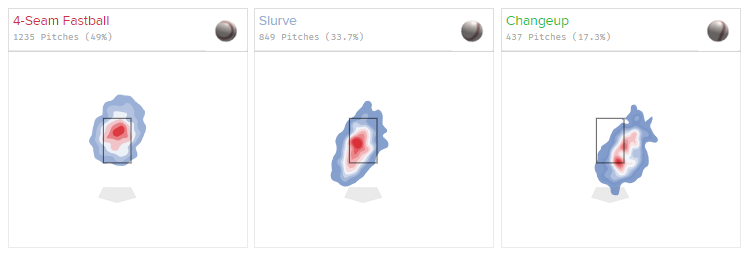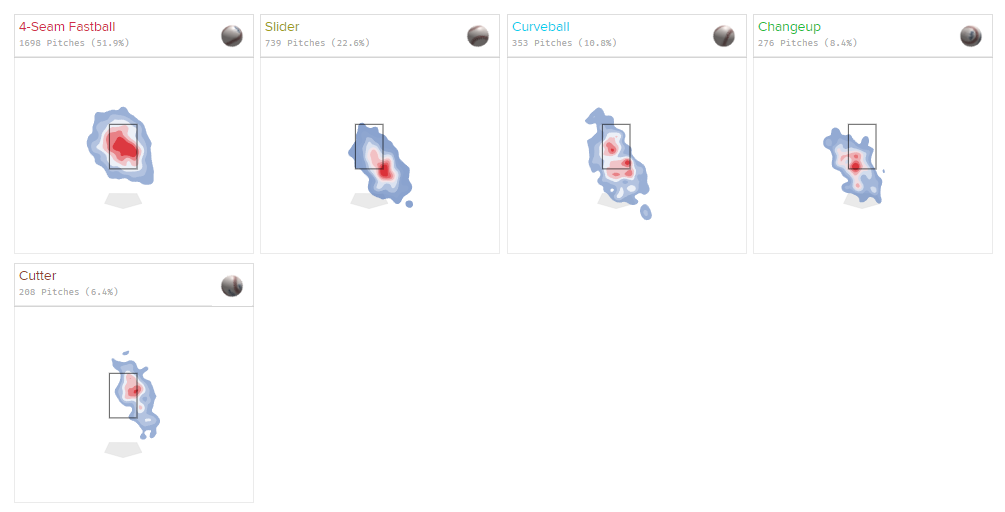For years, if a player passed the hallowed marks of 500 home runs and 300 career wins, they were punching a guaranteed ticket to Cooperstown.
However, over time this changed, at least for hitters, as the steroid-era produced monster numbers and enhanced the career numbers for a collection of sluggers who will likely never make the Hall of Fame, such as Sammy Sosa, Mark McGwire, and Rafael Palmeiro.
While hitting the 500 home run milestone got easier for a while, changes to the game have made it harder for a pitcher to win 300 games. There are only 24 members in one of baseball’s most exclusive fraternities: the 300-win club.
Many of these players gobbled up wins in the early days of baseball, such as John Clarkson, who played for 12 seasons in the late 1800s and captured 328 wins in his career (including epic seasons of 53 and 49 wins), or Mickey Welch, who retired in 1892 after 13 seasons and 307 wins.
And more recently, we’ll probably never see a nucleus like the Mount Rushmore of pitchers listed below, who each played for 20+ seasons and ended their career in the 2000s.
- Roger Clemens (354) – 24 seasons
- Greg Maddux (355) – 23 seasons
- Tom Glavine (308) – 22 seasons
- Randy Johnson (303) – 22 seasons
Since that time, we’ve had some other electric young arms who looked like they might have a chance. Tim Lincecum had 89 career wins and two Cy Young Awards in his 20s, but his slight build and funky delivery put a lot of stress on his arm. He won only 21 more games in his career before retiring at 32.
Félix Hernández had the advantage of making it to the big leagues at a young age (19) and had won a remarkable 143 games before he turned 30. He was arguably on track for 300 but won only 26 total games in his 30s and retired at the relatively young age of 33. Hernández was hamstrung by the Mariners’ lack of run support which limited his opportunities for wins.
The recent kings of longevity were Jaime Moyer and Bartolo Colón. Moyer had one of the most unique careers in modern baseball. He played for a remarkable 25 seasons and retired with 269 wins. He had an ERA of 4.56 and won a total of only 34 games in his 20s, with a 34-54 record.
He righted the ship to win 130 games with an ERA of 3.97 over the next decade. At that point, he probably seemed a long shot to make the 300-win club, but he again won over 100 games in his 40s (105 to be exact) and retired with 269 wins. His career record came out to 269-209, a .563 winning percentage. He was doomed by some poor seasons early in his career, and had he been even a .500 pitcher in his 20s, that would have raised his total to 279 wins.
Colón played 21 seasons in the majors and retired at age 45. His career record was 247-188, which comes out to a .568 winning percentage, better than Moyer’s, but not quite good enough for 300. Colón was a solid starter for many seasons and even won a Cy Young Award, but he had a career ERA above 4.00 and was a tier below the best aces in the game. He would have needed a few more wins per season and may have even needed to play a few more seasons to hit 300.
For projection’s sake, if you bump his career winning percentage up to .600 that gets him to 261 wins, but he doesn’t hit 300 wins unless you raise his career winning percentage to .690 – a mark just below Clayton Kershaw’s .6937, which is fourth all-time.
This shows us some pitchers have elite stuff, while others have elite longevity – but it takes both to reach 300 wins. As pitchers average shorter outings and fewer innings, have changes to the game and strategy made it impossible for anyone to join the 300-win club? Will the club ever welcome a 25th member?
Let’s explore these questions further by crunching the numbers and reviewing first the active leaders in career wins.
- 244 wins: Justin Verlander – 40 years old
- 223 wins: Zack Greinke – 38 years old
- 201 wins: Max Scherzer – 37 years old
- 197 wins: Clayton Kershaw – 34 years old
- 195 wins: Adam Wainwright – 40 years old
- 163 wins: Cole Hamels – 38 years old
- 157 wins: David Price – 36 years old
- 143 wins: Johnny Cueto – 36 years old
- 134 wins: Madison Bumgarner – 33 years old
- 130 wins: Gerrit Cole – 32 years old
Not many surprises at the top of this list, with Justin Verlander, Zack Greinke, Max Scherzer, and Clayton Kershaw in the top four positions. Next is the ageless Adam Wainwright, still going strong at age 40 and with 195 wins to his name.
The list also contains some pitchers who likely won’t add many more wins to their totals like Cole Hamels who hasn’t seen significant playing time in a few seasons, or David Price, who is not officially retired but is likely done for his career stuck on 157 wins.
Next is Madison Bumgarner, who made his big league debut at age 19 and had immediate success in his 20s.
Looking back at Mad Bum’s career with the Giants, he won a total of 119 wins in his 20s, despite single-digit wins in 2017, 2018, and 2019.
In 2020, Bumgarner joined the Diamondbacks, and unfortunately, for Arizona fans, he has not captured the same magic that he had in San Francisco. In the past three seasons, he’s gone a combined 15-29 with a bloated 4.98 ERA. If you flip his record in the desert, he would be almost halfway there (148) at age 33. Bumgarner may recover to be a serviceable starter for a few more seasons but now it looks like he may not pass 200 career wins.
After Bumgarner is Gerrit Cole, who we will get to in further detail later. The biggest surprise on this list is Johnny Cueto with 143 wins. Cueto has played for 15 seasons but has only six double-digit win seasons to his name. Like others on the list, he was sharp in his 20s and slowed down in his 30s. He did have a mini-bounce back year with the White Sox last season, going 8-10 with a 3.35 ERA. If Cueto can play a few more seasons, he could end up in the 165 – 175 win range for his career but will fall well short of 300.
Projecting the rest of anyone’s career can be a fool’s errand, but let’s review the players with the best shot at 300 wins.
Best Chances at 300
5. Julio Urías
| Year | Wins | Losses | Era | GS | IP |
|---|---|---|---|---|---|
| 2016 | 5 | 2 | 3.39 | 15 | 77 |
| 2017 | 0 | 2 | 5.4 | 5 | 23.1 |
| 2018 | 0 | 0 | 0 | 0 | 4 |
| 2019 | 4 | 3 | 2.49 | 8 | 79.2 |
| 2020 | 3 | 0 | 3.27 | 10 | 55 |
| 2021 | 20 | 3 | 2.96 | 32 | 185.2 |
| 2022 | 17 | 7 | 2.16 | 31 | 175 |
Urias is an interesting case to examine as he was one of those players to make it into the majors at a young age (19) but didn’t have immediate success like Félix Hernández or Madison Bumgarner.
After winning five games during his rookie season, Urías was inconsistent for the next four seasons and only won seven games from 2017 – 2020. During this time he had a number of high and lows, which included: being demoted back to the minors in 2017, getting injured and missing most of the 2017 and 2018 seasons, and being suspended 20 games for domestic abuse in 2019. On the other hand, he did have some positive moments as he pitched in big playoff moments in 2018, 2019, and 2020. However, he wasn’t used as a traditional starter and pitched in relief limiting the number of win opportunities.
So what changed for Urías that made him more successful in the last few years? He’s refined his approach as his career has progressed. As recently as 2019, he was throwing five different pitches. That year he threw his fastball 60% of the time and averaged 95 MPH with it, along with a slider, changeup, curveball, and the occasional sinker.

Source: Baseball Savant
Then if we review last season’s mix distribution, Urías narrowed his focus to throwing three pitches. He first made the decision to combine his slider and curveball in 2020 and has concentrated it into a tighter area within the strike zone.

Source: Baseball Savant
The slurve has less vertical movement (an average of 42.5 inches of drop in 2021-2022 to 56.5 in 2019-2020) and more horizontal movement (an average of 16.05 inches of break in 2021-2022 to 8.05 in 2019-2020) when compared to the years he used the traditional curveball.
He also added some heat to his changeup, which averaged 86 MPH, up from 82 in 2019. Urías improved his control, cutting down walks from earlier in his career, averaging a 4.7 BB% in 2021 and a 6.0 BB% in 2022, down from 8.0% in 2018 & 2019. These changes led to big improvements in recent years.
In 2021, he finally returned to full-time starter duty and had an excellent season. Urías started 32 games and led the majors in wins, going 20-3 with a 2.96 ERA and a 1.02 WHIP, and striking out 195 batters in 185.2 innings. Last season he went 17-7, led the National League in ERA with 2.16, and lowered his WHIP to 0.96.
His 37 wins over the past two seasons (average of 18.5 wins/season) raise his career total to 49 games at 26 years old. If you take a more conservative approach and say he wins an average of 12 games over the next four seasons, that would get him to 97 wins at age 30.
A more aggressive projection of 15 wins would get him to 109. If he someone kept the torrid 18.5 win pace of 2021-2022, he would be at 123 wins at age 30.
4. Aaron Nola
If we go farther down the current active win leaders list to pitchers still in their 20s, we come upon Aaron Nola, José Berríos, and Germán Márquez.
Active Leaders in Career Wins in Their 20s
78 wins: Aaron Nola – 29 years old
72 wins: José Berríos – 28 years old
63 wins: Germán Márquez – 27 years old
Of those names, Aaron Nola probably has the best chance to win the most career games. Berrios took a step backward last season and as for Márquez, this would be a Sisyphean task as no pitcher is going to win 300 games pitching his home games at Coors Field.
Nola debuted in the major leagues at the age of 22 and has a career single-season high of 17 wins in 2018. He has three other 10+ win seasons to his name and went an unlucky 11-13 last season with an ERA of 3.25. Nola had 235 strikeouts in 205 IP and his 1.3 BB/9 led the National League.
Nola’s most frequently used pitch is his fastball – which he used 51% of the time in 2022. He was in the 81st percentile for Zone% with 54.6 and 91st percentile for CS% with 22.2%.

This shows one of Nola’s strengths: efficiency. He is a strike thrower who doesn’t walk many people and is efficient with his pitches.
He doesn’t have overpowering velocity and averages around 92 – 93 MPH on his fastball so he isn’t winning games by blowing past hitters. The effectiveness of his fastball is its movement.
Nola’s consistently among the league leaders in horizontal movement on his four-seamer. Last season he averaged 13 inches of break on the pitch, which was 21st in the league. In 2021, his 13.3 inches of break ranked 15th, and in 202o, he was 12th with 13.8 inches of break.
Another positive for Nola is that he plays for a marquee team with a strong lineup that will offer run support. He’s signed through the end of this season and if he decides to stay in Philadelphia, he’ll be on a good team for the foreseeable future. His strong control skills will also support him as he ages.
Nola’s currently in the prime of his career, having played eight seasons in the major leagues, and has averaged 13 wins a season. At that pace, he would need to play 17 more seasons to get close to 300. That would put him among all-time longevity guys like Colón and Moyer if he can remain healthy and can reel off some seasons with wins in the upper teens or even lower 20s that would help his case. It’s not impossible but it’s still a long shot.
3. Gerrit Cole
Cole debuted with the Pirates at age 22, older than some of the other phenoms on this list, but has been more consistent than Urías and has shown more staying power than someone like Bumgarner.
He won 21 games during his first two seasons and then was a first-time All-Star in 2015 after going 19-8 with a 2.60 ERA and finishing fourth in Cy Young voting. Cole made the move to Houston in 2018 and collected 35 wins in two seasons, before joining the Yankees for the last three seasons. Last season, he eclipsed 200 innings pitched for the fifth time in his career and led the major leagues with 257 strikeouts. He finished with a 13-8 record.
Cole maintains a deep repertoire of pitchers, throwing five different pitches: a four-seamer, slider, curveball, changeup, and cutter.
He relied on his fastball 51% of the time in 2022, and the pitch is one of the most effective in the game, averaging 98 MPH, which puts him in the 97th percentile among starting pitchers. The CSW% for his fastball in 2022 was 35.5% which led the major leagues.
His secondary pitch is his slider, which averaged 88.7 MPH and had a SwStr% of 25.1. These marks put him in the 96th percentile in both categories.

Source: Baseball Savant
This strong pitch mix regularly puts him among the league leaders in strikeouts and K%.
These powerful pitches have led to six seasons of 30 or more starts and eight double-digit win seasons, which adds up to a career record of 130 – 71 (0.646%). Cole has persistently won games at a higher rate than his peers and ranks fifth among active leaders in win/loss percentage, behind Clayton Kershaw, Max Scherzer, David Price, and Justin Verlander. Thus far in his career, Cole has averaged 13 wins a year.
He’ll be in New York through the 2028 season so the wins should keep piling up. If he can average 15 wins until that time, he will be at 220 wins at age 38. He would obviously need to play into his 40s to have a chance at 300 and at that point in his career, he won’t be averaging 15 wins. However, if Cole could average 12 wins and play until he was 42 years old, he would be at 268 wins, knocking on the door of 300. He has the best chance of any pitcher not named Greinke or Verlander to hit 300.
2. Zack Greinke


Great job on penning this article, I like the way you seamlessly wove in the advanced analytics. Barring some freak injury, I think it’s a given JV will win 300. And also I think Max Scherzer has a much better shot than people give him credit for. max has always been a workhorse, and at 38 he is still at the top of his game. I could see him playing till 45 as as well and achieving that milestone.